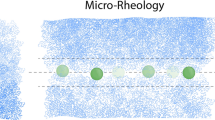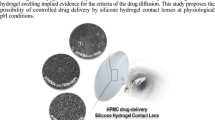Abstract
Biphasic hydrogel polymers are in the forefront of new extended wear contact lens development. In the biphasic hydrogel the objective is to produce co-continuous domains of siloxane units for high oxygen permeability, coupled with hydrophilic units forming aqueous channels for hydraulic and ion mobility. These are distributed in phase separated nano-scale regions such that the material is optically clear while achieving the required properties to maintain corneal health and lens movement.
This paper describes how Impedance Spectroscopy permits a rapid measurement of ion conductivity in a range of silicone and non-silicone hydrogel materials with water contents ranging from 18% to 75% equilibrium water content. For non-silicone hydrogels relative sodium ion conductivity follows a typical percolation curve. However, for silicone hydrogels ion mobility is three orders of magnitude higher than conventional hydrogels of the same equilibrium water content.
The influence of electrolyte concentration, interfacial electrode sample contact pressure and temperature are also reported.
Similar content being viewed by others
References
O. Witcherle and D. Lim, Hydrophillic gels for biological use, Nature185, 117–118 (1960).
T. Hirt, US patent 6039913 (2000).
J. Kunzler, R. Ozark, Fluorosilicone hydrogels, US patent 5321108 (1994).
J. Kunzler, R. Ozark, Hydrogels based on hydrophilic side-chains siloxanes, Journal of Applied Polymer Science55, 611–619 (1994).
Y. Lai, Role of Bulky Polysiloxanylalkyl methacrylates in oxygen-permeable hydrogel materials, Journal of applied polymer science56, 317–324 (1995).
P.C. Nicolson, J. Vogt, Soft contact lens polymers: an evolution, Biomaterials22, 3273–3283 (2001).
A. Domschke, D. Lohman, L. Winterton, On-eye mobility of soft oxygen permeable contact lenses, Proceedings of the ACS Spring National Meeting, San Francisco: PMSE. (1997).
D. Austin, D. Champeney, A Technique for Measuring the Alternating Current Electrical Conductivity of Hydrogels, Journal of the BCLA18, 115–118. (1995).
D. Austin, The Electrical Conductivity of Soft Contact Lens Hydrogels, MPhil Thesis, School of Physics, UEA, Norwich, UK. (1996).
C.M. Weikart, M. Miyama, H.K. Yasuda, Surface modification of conventional polymers by depositing plasma polymers of trimethylsilane and Trimethlysilane+O2, Journal of Colloid and interfacial Science211, 28–38 (1999).
B.J. Tighe, Silicone Hydrogel Materials-How do they work? in: Silicone Hydrogels: the rebirth of extended wear contact lenses (D. Sweeney, Ed.) Butterworth Heinemann, 2000.
B. Tighe, Hydrogel materials: The patents and the products, Optician pp. 17–24 (1989).
P.H. Corkhill, A.M. Jolly, C.O. Ng and B.J. Tighe, Synthetic Hydrogels: 1. Hydroxyalkyl acrylate and methacrylate copolymers-water binding studies, Polymer28, 1758–1765 (1987).
V.J. McBrierty, S.J. Martin, F.E. Karasz, Understanding hydrated polymers: the perspective of NMR, Journal of Molecular Liquids80, 179–205, (1999).
A. Lopez-Alemany, V. Compan, M. Refojo, Porous Structure of Purevision versus Focus Night & Day and Conventional Hydrogel Contact Lenses, Journal of Biomedical Material Research63, 319–325 (2002).
D.L. Koch and A.S. Sangani, The AC Electrical Impedance of a Fractal Boundary to an Electrolytic Solution, J. Electrchem. Soc.138, No. 2, 475 (1991).
E. Barsoukov, J.R. Macdonald, Impedance Spectroscopy, Theory, Experiment and Applications, Wiley, 87 (2005).
J.E.B. Randles, Kinetics of Rapid Electrode Reactions, Disc. Faraday Soc.1, 11–19 (1947).
B.B. Damaskin, The Principles of Current Methods for the Study of Electrochemical Reactions, Mc Graw Hill Inc. 61–78 (1965).
L. Nyikos and T. Pajkossy, Fractal Dimension and Fractional Power Frequency-Dependent Impedance of Blocking Electrodes, Electrochimica Acta30, 1533–1540 (1985).
R. De Levie, On Porous Electrodes in Electrolyte Solutions, Electrochimca Acta9, 1231–1245 (1964).
R. De Levie, The Influence of Surface Roughness of Solid Electrodes on Electrochemical Measurements, Electrochimca Acta10, 113–130 (1965).
J.R. Macdonald, Impedance Spectroscopy: Old Problems and New developments, Electrochimica Acta30, No. 10, 1483–1492 (1990).
W. Scheider, Theory of the Frequency Dispersion of Electrode Polarization, Topology of Networks with Fractional Frequency Dependence, The Journal of Physical Chemistry79, No. 2. 127–135 (1975).
P.H. Bottelberghs, Low-Frequency Measurements on Solid Electrolytes and Their Interpretations, in: Solid Electrolytes (P. Hagenmuller and W. Van Gool, Eds.) Academic Press, 1978.
L. Nyikos, and T. Pajkossy, Diffusion to Fractal Surfaces, Electrochimica Acta31, 1347–1350 (1986).
X. Qian et al., Methods to study the ionic conductivity of polymeric electrolytes using a.c. impedance spectroscopy, J. Solid State Electrochem.6, 8–15 (2001).
T. Isono, J. Chem. Eng. Data29(1), 45–52 (1984).
N. Lakshminararayanaiah, Transport Phenomena in Membranes, Academic Press, 1969, p. 226.
R.A. Robinson and R.H. Stokes, Electrolyte Solutions, Butterworths, 1968, p. 133–147.
R.A. Robinson and R.H. Stokes, Electrolyte Solutions, Butterworths, 1968, p. 87.
Author information
Authors and Affiliations
Rights and permissions
About this article
Cite this article
Austin, D., Kumar, R.V. Ionic conductivity in hydrogels for contact lens applications. Ionics 11, 262–268 (2005). https://doi.org/10.1007/BF02430387
Received:
Accepted:
Issue Date:
DOI: https://doi.org/10.1007/BF02430387




